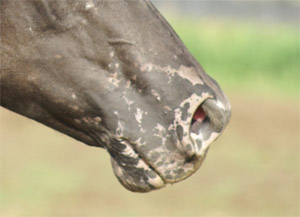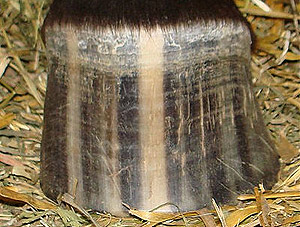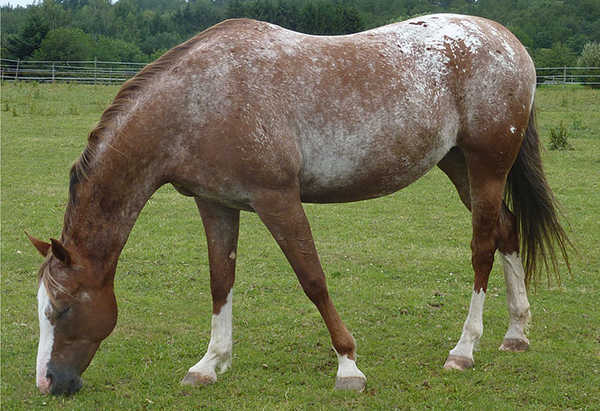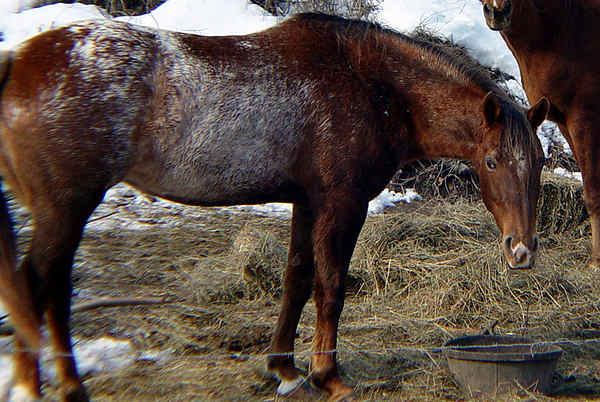A young reader wrote to say his father just bought an Appaloosa, and now he wanted to know about its spots, its small tail, and its discolored mouth.
The Appaloosa is a favorite breed of mine simply because my grandfather had one on his small ranch in Hawaii when I was growing up. That horse was probably one of the best cow horses that I've ever seen. It was always a great horse to ride -- even for a teenager who wanted a horse that could do it all.
The Appaloosa is a favorite breed of mine simply because my grandfather had one on his small ranch in Hawaii when I was growing up. That horse was probably one of the best cow horses that I've ever seen. It was always a great horse to ride -- even for a teenager who wanted a horse that could do it all.
Researchers have found Eurasian prehistoric cave paintings depicting leopard-spotted horses. Domesticated horses with leopard complex spotting patterns have been depicted in art dating as far back as Ancient Greece, Ancient Persia, and the Han Dynasty in China. Their spotted horses were a favorite of European nobility going back to the 11th century. By the mid-18th-century, there was an even greater demand for horses with the "leopard complex" spotting pattern among European royalty.
In Europe, these horses were used in horsemanship schools, for parade use, and other forms of display. The Spanish probably obtained spotted horses through trade with southern Austria and Hungary, where the color pattern existed. The Spanish introduced horses to North America as they explored the American continent in the 1500s. Eventually, as those horses found their way into the lives of Indian tribes and were traded to other tribes, their use spread until most of the Native American populations in the Northwest were mounted by the 1700s.
In Europe, these horses were used in horsemanship schools, for parade use, and other forms of display. The Spanish probably obtained spotted horses through trade with southern Austria and Hungary, where the color pattern existed. The Spanish introduced horses to North America as they explored the American continent in the 1500s. Eventually, as those horses found their way into the lives of Indian tribes and were traded to other tribes, their use spread until most of the Native American populations in the Northwest were mounted by the 1700s.
The Nez Perce developed strict breeding selection practices for their animals, establishing breeding herds as early as 1750. Historians believe they were the first tribe to breed selectively for specific traits such as intelligence, speed, and physical characteristics. They kept the best and trading away those that were less desirable. Believe it or not, the Nez Perce were one of the few tribes that actively used the practice of gelding inferior male horses and trading away poor stock to remove unsuitable animals from the gene pool.
By the early 1800s, the Nez Perce were noted for being excellent horse breeders. All while becoming especially sophisticated horsemen. And their mounts, which included many spotted individuals, were prized and envied by other tribes. When white settlers came to the Northwest Palouse region, they called the spotted horses "Palouse horses" or "a Palouse horse." Over time the name was shortened and slurred to "Appalousey" and finally "Appaloosa."
During the Nez Perce War of 1877, Appaloosa horses helped the Nez Perce Indians avoid battles and elude the U.S. Cavalry for several months. It is said that the tribe fled over 1,300 miles of rugged, punishing terrain under the guidance of the famed Chief Joseph. When they were defeated in Montana, their surviving horses were surrendered to soldiers, left behind, or dispersed to settlers.
After being in decline for many years and because nothing was being done to preserve the Appaloosa breed, finally, a group of dedicated horsemen formed the Appaloosa Horse Club. It was formed in 1938 for the preservation and improvement of the diminishing spotted horse.
So now, let's talk about the physical characteristics of the breed, which we call Appaloosa. Although Appaloosas are most commonly recognized by their colorful coat patterns, they also have other distinctive characteristics.
Basic to Appaloosa is the "Leopard Complex." A leopard complex is a group of genetically related coat patterns in horses. These patterns range from progressive increases in interspersed white hair similar to graying or roan to distinctive, Dalmatian-like leopard spots on a white coat. Secondary characteristics associated with the leopard complex include mottled skin, striped hooves, and a white sclera around the horse's eye. Though its presence in breeds from Asia to western Europe has indicated that it is due to a very ancient mutation, these patterns are most closely identified with the Appaloosa.
The four identifiable Appaloosa breed characteristics are: 1) Mottled Skin, 2) White Sclera, 3) Striped Hooves, 4) Short Mane & Tail, and 5) Coat Patterns.
1) Mottled Skin

This characteristic is unique to the Appaloosa horse. Therefore, mottled skin is a basic and decisive indicator of an Appaloosa. Appaloosa will almost always have mottling or small dots around their mucus membranes, mouth, eyes, etc. On light or pink skin, the freckles are dark, and they are pink or white on dark skin. Mottled skin is different from commonly found pink flesh-colored or non-pigmented skin in that it normally contains dark areas of pigmented skin within its area.
The result is a speckled or blotchy pattern of pigmented and non-pigmented skin. When identifying mottled skin, it is important to not confuse it with simple differences in pigmentation, patches of light and dark skin, and pumpkin skin.
2) White Sclera

Also called walleyed, often appaloosa animals will display a white sclera of the eye. The sclera is the area of the eye that encircles the iris -- the colored or pigmented portion. The white of the human eye is an example. All horses have sclera, but the Appaloosa's is white and usually more readily visible than other breeds.
All horses can show white around the eye if it is rolled back, up, or down or if the eyelid is lifted. The readily visible white sclera is a distinctive Appaloosa characteristic, provided it is not in combination with a large white face marking, such as a bald face. But remember, not all appaloosas will display this trait.

All horses can show white around the eye if it is rolled back, up, or down or if the eyelid is lifted. The readily visible white sclera is a distinctive Appaloosa characteristic, provided it is not in combination with a large white face marking, such as a bald face. But remember, not all appaloosas will display this trait.
3) Striped Hooves

Many Appaloosas will have bold and clearly defined vertically light or dark striped hooves. Vertical stripes may result from an injury to the coronet or a white marking on the leg. Also, light-colored horses tend to have thin stripes in their hooves. As a result, all striped hooves do not necessarily distinguish Appaloosas from non-Appaloosas. Remember that not all hooves will display the striping, and it does not matter what color the legs are. They can all be stripped.
4) Short Mane & Tail

With some horse breeds, a long flowing mane and tail are considered crowning achievements. That's not generally the case for Appaloosa horses. Appaloosa tends to have a short, sparse mane and tail. The latter is sometimes called a "rat tail." Believe it or not, the small tail served a purpose for the Nez Perce.

While not all, some Appaloosas tails tend to grow very sparsely, and the hair won’t grow very long past the end of the tail bone. Not to worry, though, because if an Appy has a short tail and sparse mane, it probably means that horse has more of the original breed's blood running in his veins.
5) Appaloosa Coat Patterns
There is an immeasurable number of patterns in the appaloosa spectrum, and they can be, and often are mixed and matched. A horse must have a recognizable coat pattern or mottled skin and one other characteristic to receive regular registration. Horses that receive regular registration are issued numbers. No letters precede the number.
Those not displaying a coat pattern or mottled skin and one other characteristic will be classified as non-characteristic (N/C)) and their registration numbers preceded by the letter "N." Horses who completed the Certified Pedigree Option (CPO) program were issued numbers preceded by the letters "CN."
 |
| LOCATIONS OF PATTERNS |
In reviewing the descriptions of various coat patterns, the necessity of correctly specifying anatomical regions of the horse probably became quite apparent. The five classifications of blanket pattern locations used by most Appaloosa organizations are:
1. Hips
2. Loin and hips
3. Back and hips -- markings extend over a portion of the back, up to the withers.
4. Body and hips -- markings extend from the hips, including a portion of the shoulders and/or neck, but do not cover the entire horse.
5.Entire body -- markings cover the head, neck, shoulder, back, loin hips, and upper legs.
Appaloosa patterns are expressed through the Leopard Complex and can appear on both chestnut and black base coats. White color patterns are not linked to the color of the horse. They are a pattern applied on top of the base coat. The Leopard Complex creates an incredibly diverse number of patterns and types and can be found across many breeds. While they are associated with Native Americans, spotted animals have been documented in history for thousands of years.
The appy white pattern can occur on any color and varies a great deal in expression. Some animals can display more than one pattern. While the patterns vary widely from animal to animal, a few characteristics remain constant across all animals affected by this white pattern.
Here are the coat patterns starting with the most common:
Blanket
This pattern produces animals of a dark base color with a blanket of white across the hindquarters. The spots inside the blanket are the same color as the horse's base coat. Edges can be clean or roaned, and they must have spots of their base color on the field of white. As with most appaloosa patterns, spots may move and change with each shedding.
Leopard
Above is Ally Hurt of Whitewright, Texas,
with her Leopard Appaloosa
The Leopard pattern is dark spots of varying sizes over a white body. Named for the Leopard complex, these animals are pure white with dark base colored spots fairly evenly distributed throughout the coat – similar to Dalmations. Spots can be concentrated on the head and legs.
Few Spot Leopard / Near Leopard
Few Spot Leopard patter is the maximum expression of the Leopard Complex and creates an animal that is pure white with a few colored spots in their coat, generally on the flank, elbow, neck, and head. They can also display varnish marks or roaning. Yes, a nearly white horse from birth retains color just above the hooves, the knees, "armpits," mane and tail, windpipe, and face.
Marble or Varnish Roan
Varnish roan may look like it and are often mistaken for them. It is not the result of the roan white pattern or a grey modifier. A Varnish roan Appaloosa pattern is a mix of body and white hairs that extends over the entire body -- no relation to true roan. They result from the Leopard Complex and are born the base color often with some spotting and begin to blur or fade as they age. Animals often retain their base color over bony parts.
Roan is a horse coat color pattern characterized by an even mixture of colored and white hairs on the body, while the head and "points," lower legs, mane, and tail, are mostly solid-colored. The roan pattern is dominantly inherited and is found in many horse breeds. Horses with roan coats have white hairs evenly intermingled throughout any other color. The head, legs, mane, and tail have fewer scattered white hairs or none at all.
The Frost pattern is similar to varnish, but the white hairs are limited to the back, loins, and neck. Often mistaken for roan, frosted animals will not display the dark points characteristic of roan animals. Frost appaloosas white patterning generally occurs along the topline and hips.
Snowflake
Snowflake patterns are white spots on a dark body. Typically the white spots increase in number and size as the horse ages. Snowflake appys vary from tiny flecks of white to a larger pattern of white across the body. They will not display a blanket over their hindquarters but randomly over the body, which can enlarge as the horse ages. Snowflake appys often grow lighter as they age.
Snowcap
Similar to the Blanket Appys, except the Blanket field doesn’t have spots in it. Snowcap Appaloosas have a solid blanket that can extend across most of the body, but they usually retain their base color on the head, legs, flanks, and elbows.
The Appaloosa Today
The modern breed maintains bloodlines tracing to the foundation bloodstock of the registry; its partially open stud book allows the addition of some Thoroughbred, American Quarter Horse, and Arabian blood. Today, the Appaloosa is one of the most popular breeds in the United States; it was named the official state horse of Idaho in 1975. And yes, the Appaloosa is the mascot for the Florida State Seminoles.
Appaloosa is best known as a great stock horse, an outstanding cow horse, and used in several Western riding disciplines. They are so versatile a breed that they are seen at Pennings, Sortings, Ropings, and just about any other Rodeo or equine event. Appaloosas have been used in many movies. And if you think Appys are small horses, think again. Even big men like John Wayne rode Appaloosas. In fact, I read somewhere that Appaloosas were a favorite choice for America's Greatest western star.
Appaloosa bloodlines have influenced other horse breeds, including the Pony of the Americas, the Nez Perce Horse, and several gaited horse breeds. Besides here in the United States, today, one can find Appaloosa horses in Europe. And believe it or not, also in Africa and Asia. That says a great deal about the Appaloosa. It says a lot about just how hardy a breed it is. Not surprising since it's proven itself over the years.
Today we can thank the Nex Perce for breeding such a horse. But also, the Appaloosa Horse Club for keeping alive that gift of God which we call the Appaloosa. And yes, that's just the way I see it.
Tom Correa






.jpg)




.jpg)
BEST BREED EVER!!! THIS ANIMAL IS A LOVING, COMPASSIONATE, HARD PLAYING & WORKING BREED. MISS MY LEOPARD, SKIPPY'S DANDY.
ReplyDeleteYour site is great. Learned a lot and have always love the Appy. Thank you!!
ReplyDeleteThe Appaloosa is my second favorite horse. John Wayne rode one in the movie "El Dorado" and I think the Cisco Kid did as well. If I could ride any horse on Earth, it would be that one. Either that or the Palomino, which I also like. Thanks as always, Tom.
ReplyDelete